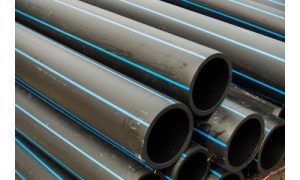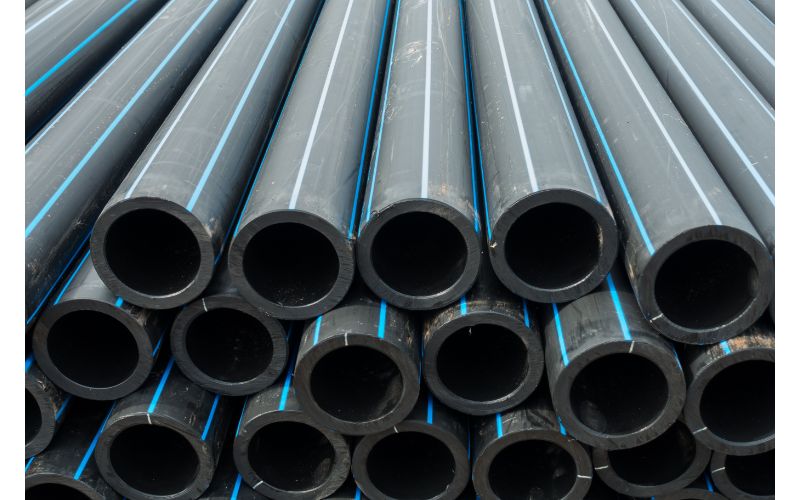Our modern society’s smooth operation depends critically on the world of pipelines. This applies to everything from the complex networks that fuel our industries to the vast infrastructure systems that support our cities. One of the many pipe materials that stand out is High-Density Polyethylene (HDPE).
So, what is HDPE pipe? High-Density Polyethylene pipes are made from a polymer called high-density polyethylene. Due to their unusual molecular structure, these pipes have a high strength-to-weight ratio while remaining relatively light in weight.
This article will take you through the numerous applications where HDPE pipes excel, the benefits of HDPE pipes, and their potential drawbacks. We’ll also highlight the key differences between HDPE and polyethylene pipes.
What Is A HDPE Pipe?
HDPE pipes are flexible plastic pipes that are employed in the transportation of fluids and gasses. They frequently replace deteriorating concrete or steel pipelines because of their many advantages.
The discovery of HDPE dates back to 1953 when Karl Ziegler and Erhard Holzkamp first synthesized high-density polyethylene. HDPE pipes are designed to operate effectively in a wide temperature range, from as low as -220°F (-140°C) to as high as +180°F (82°C).
However, it is recommended to avoid using HDPE pipes when the fluid temperature exceeds 122°F (50°C) to ensure optimal performance and longevity.
The manufacturing process of HDPE pipes involves the polymerization of ethylene. Various additives, such as softeners, stabilizers, flame retardants, lubricants, ultraviolet degradable additives, etc., are incorporated to produce the final HDPE pipe and its components.

How Are HDPE Pipe Lengths Made, And How Is The Pipe Thickness Determined?
HDPE pipe lengths are produced through a manufacturing process known as extrusion. Here is a step-by-step explanation of how HDPE pipe lengths are made:
- Resin Preparation: The process begins with preparing HDPE resin, typically in small pellets or granules.
- Resin Heating: The heating process transforms the resin from a solid state into a molten form, making it suitable for extrusion.
- Extrusion Process: The molten HDPE resin is then fed into an extruder, a machine consisting of a rotating screw within a heated barrel. The screw conveys the molten resin along the barrel while applying pressure and heat to melt the resin uniformly.
- Die Design: A specially created die shapes the molten HDPE resin as it passes the extruder’s end. The die determines the extruded pipe’s diameter and other characteristics, including shape.
- Pipe Formation: As the molten resin exits the die, it is rapidly cooled using a water cooling system or a cooling chamber. This cooling process solidifies the molten HDPE into a continuous pipe shape.
- Sizing and Calibration: The newly formed pipe is then passed through a sizing and calibration process. The maximum length of an HDPE pipe is 30 meters, but it is typically produced in standard lengths of 6, 10, 12, 15, and 20 meters.
However, on-demand, 50 and 100-meter lengths of HDPE pipe can be produced.
- Thickness Of The Pipe: This is determined during the extrusion process primarily by the die size, screw speed, and haul-off speed.
Types Of HDPE Pipe
The following are types of High-Density Polyethylene pipes:
- PE 100 HDPE Pipes: PE 100 HDPE pipes are made from higher-density polyethylene than standard HDPE pipes. These pipes are commonly used for high-pressure applications, such as water and wastewater transportation, mining, and industrial processes.
- PE 80 HDPE Pipes: PE 80 HDPE pipes are made from a lower-density polyethylene material than PE 100. They are primarily used for low-pressure irrigation, landscaping, and drainage systems.
- PE 63 HDPE Pipes: PE 63 HDPE pipes are another type of high-density polyethylene pipes widely used in various applications. They are manufactured from lower-density polyethylene than PE 80 and PE 100 pipes.
These pipes are commonly used for water distribution in rural areas and small-scale industrial processes.
- Double-Wall Corrugated HDPE Pipes: These pipes are made of two layers: an inner smooth layer and an outer corrugated layer. With this design, flexibility is maintained while stiffness and strength are increased.
They make a popular choice for underground cable protection and stormwater management.
- Large-Diameter HDPE Pipes: These are designed to cater to applications, requiring large volumes of fluids or gasses. These pipes have a diameter typically exceeding 20 inches (500 mm) and are used in water transmission, marine outfalls, and industrial projects.
Applications Of HDPE Pipes
Here are some of the common applications where HDPE pipes are widely employed:
1. Water Supply Systems
Both potable and non-potable water supply systems frequently employ HDPE pipes. They are the preferred option for water distribution networks in cities, neighborhoods, and commercial structures.
HDPE pipes’ excellent resistance to corrosion, chemicals, and biological growth ensures the delivery of clean and safe water.
2. Gas Distribution Networks
Natural gas and other gasses are frequently transported using HDPE pipes in gas distribution networks. HDPE pipes offer a reliable and leak-free system for gas transmission.
They ensure the safety of gas supply to residential, commercial, and industrial consumers. And offer superior resistance to the corrosive effects of the gas.
3. Irrigation Systems
HDPE pipes are commonly used in agricultural irrigation systems. They are suitable for both surface and subsurface irrigation methods. HDPE pipes offer flexibility, allowing easy installation and adaptation to different terrain conditions.
4. Mining Operations
HDPE pipes are extensively used in the mining industry for various applications, including dewatering, slurry transportation, and tailings management.
Their durability, chemical resistance, and abrasion resistance make them suitable for the demanding and harsh conditions of mining operations.
5. Industrial Processes
Numerous industrial processes use HDPE pipes. In the chemical processing, wastewater treatment, and power generation industries, they are employed to transport chemicals, acids, and corrosive fluids.
6. Sewage Systems
The conveyance of sewage from residential, commercial, and industrial areas to treatment facilities is made possible by their durable and corrosion-resistant design. The interior surfaces of HDPE pipes are smooth, ensuring efficient flow and preventing solids buildup.
7. Infrastructure Rehabilitation
HDPE pipes are used to replace deteriorated or obsolete pipelines made of materials such as concrete or steel. Their flexibility and ease of installation allow for efficient and cost-effective rehabilitation projects.
8. Geothermal Systems
Geothermal energy systems use HDPE pipes to extract and move heat from the earth. HDPE pipes are suitable for geothermal applications due to their thermal characteristics, chemical resistance, and durability, which ensure effective heat transfer and long-term performance.
9. Landfill Systems
HDPE pipes are commonly used in landfill systems for leachate collection and management. Leachate, the liquid from decomposing waste, must be properly collected and treated to prevent environmental contamination.
Advantages of HDPE Pipes
HDPE (high-density polyethylene) pipes offer numerous advantages, making them popular for various applications.
- Extremely durable and withstand significant external loads and impacts
- Exhibit excellent resistance to chemicals, acids, and alkalis
- Have high flexibility, which aids in bending around obstacles
- A reliable and leak-free system
- The joints are resistant to soil movement and water hammer effects
- Lightweight
- Have a long service life, typically exceeding 50 years
- Environmentally friendly due to their recyclability and low carbon footprint
- Versatility allows customized solutions to meet specific project requirements
- Non-toxic and hygienic
Disadvantages Of HDPE Pipes
HDPE pipes have a lot of benefits, but it’s also important to consider their drawbacks. Let’s look at some of the main drawbacks of HDPE pipes:
- Susceptible to degradation and loss of mechanical properties when exposed to prolonged sunlight or ultraviolet (UV) radiation
- In the event of a fire, HDPE pipes can contribute to the spread and intensity of the flames, posing a potential safety risk
- Poor High-Temperature Capability
- Stress Cracking when they come into contact with chemicals
- Difficult to Bond
Is HDPE The Same As Pe?
High-density polyethylene, or HDPE, and polyethylene, or PE, are frequently used interchangeably, but there are differences between the two. Here are the distinctions:
- Density: HDPE has a higher density, typically ranging from 0.941 to 0.965 g/cm³, while PE has a lower density, typically ranging from 0.910 to 0.940 g/cm³. The higher density of HDPE imparts enhanced strength and rigidity to the material.
- Strength and Stiffness: Due to its higher density, HDPE exhibits greater tensile strength, impact resistance, and stiffness than PE.
- Applications: HDPE is frequently used in various applications, including pipes for the distribution of water and gas, sewage systems, industrial containers, geomembranes, and more.
Due to its lower density and flexibility, PE is used in electrical insulation, plastic bags, films, and packaging materials.
- Processing Methods: HDPE is often processed using extrusion. Conversely, PE is commonly processed using film extrusion or rotational molding techniques to produce flexible films or molded products.
Some Common Questions
Here are other related questions about what HDPE pipes are.
Q1: What is the difference between HDPE and PVC?
Their molecular structures, characteristics, and applications primarily distinguish them from one another. PVC is rigid and stronger, whereas HDPE is more resilient and flexible. In contrast to PVC, HDPE is better fitted for low-pressure and low-temperature applications.
Q2: How do you join HDPE pipes?
You can join HDPE pipes using several methods, including heat fusion, butt-welding, and electrofusion. Here is a video to explain more.
Q3: How long will HDPE pipe last?
HDPE pipes are renowned for having a long service life of 50 to 100 years or more. The lifespan of HDPE pipes can be extended through proper installation, regular maintenance, and adherence to industry standards.
Conclusion
HDPE pipes are a versatile and reliable solution for various piping applications. Their unique properties, including durability, chemical resistance, and flexibility, make them well-suited for various industries and environments. Likewise, they offer numerous advantages over traditional piping materials.
Also, their durability translates into longer service life, reducing the need for frequent replacements and minimizing maintenance costs. As technology advances and research continues, HDPE pipes will likely witness further enhancements for future piping applications.

